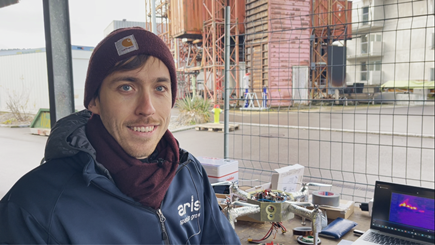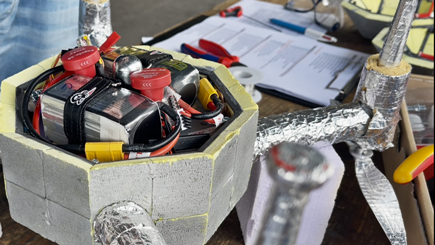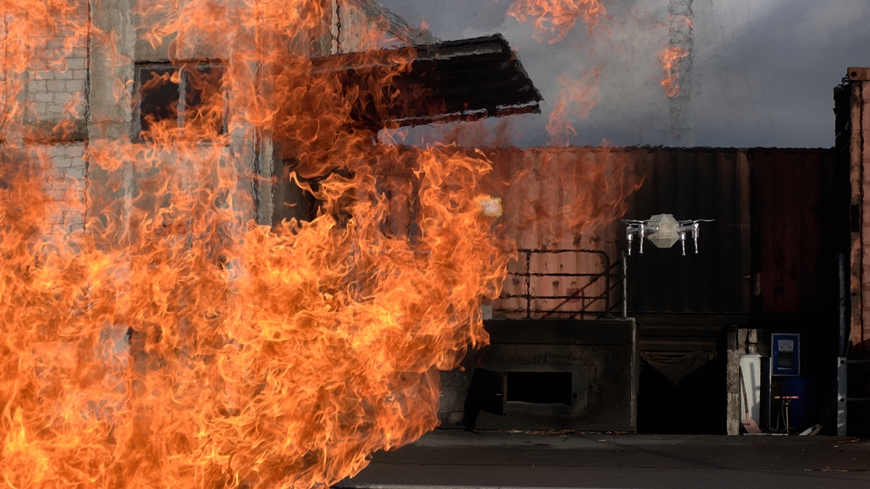Heat resistant drone for fire fighting
FireDrone supports the fire department
Researchers from Empa and Imperial College London are developing a heat-resistant drone that can analyze the source of danger at close range in the event of a building or forest fire. This allows firefighters to optimize the strategy of a high-risk operation before entering the danger zone.

Where others rush out, they have to go in: Firefighters put themselves in dangerous situations during rescue operations – sometimes right in the midst of a sea of flames. Last year, Swiss fire departments were called out for more than 12,000 firefighting missions. Since temperatures in a burning building can reach lethal levels of around 1,000 degrees Celsius, it is essential to avoid any unnecessary risk. Flying robots could support such missions: Researchers at Empa and Imperial College London are currently developing a heat-resistant drone that can provide initial data from the hot spot. Based on this information, the men and women of the response team can optimize their strategy before venturing into the inferno. "Before they go directly into the danger zone, the firefighters naturally don't know what exactly awaits them and what difficulties they will encounter," says Mirko Kovac, head of Empa's Sustainability Robotics Laboratory and the Aerial Robotics Lab at Imperial College London. Here, for example, drones equipped with cameras and CO2 (carbon dioxide) sensors could provide important information about the distribution of fire sources, unexpected hazards or trapped people.
Too hot for normal drones

Drones are already being used to fight fires, taking aerial photos, lifting fire hoses onto skyscrapers or dropping extinguishing agents in remote areas, for example to contain the spread of forest fires - but only at a safe distance from the source of the fire. "To fly closer, the extreme heat generated by a fire is too great for conventional drones," says David Häusermann of Empa's Sustainability Robotics lab. Close to the fire, the frame melts and the electronics give up. "More than aerial photos of the fire site from a safe distance are not possible with commercial drones," Häusermann says. The researcher's goal, therefore, was to develop a drone that could withstand the heat and thus provide fast and accurate data from the center of the hot spot.
Ultra-light and tough

Suitable for spacesuits

The material in question is an aerogel, an ultralight material consisting almost entirely of air-filled pores enclosed in a hint of polymer substance. In this case, the materials researchers chose an aerogel based on a polyimide plastic. Polyimide aerogels are also being researched by NASA, for example, for the insulation of space suits. However, Shanyu Zhao did not rely on polyimide alone to synthesize the aerogel: The composite material consists of polyimide and silica and is also reinforced with glass fibers. "Laboratory analyses have shown that this comparatively fire-resistant material is particularly well suited for use in drones," says aerogel researcher Zhao.
Flight into the inferno

The prototype of the FireDrone has already performed well in initial tests at Empa's flight arena in Dübendorf. The flight characteristics and controllability of the drone, which is about 50 centimeters tall, were excellent even with an aerogel insulation jacket and an additional built-in cooling system, as well as aluminum cladding to reflect heat. The design, which the researchers just published in the journal "Advanced Intelligent Systems," was convincing in this "dry run."
However, whether the aircraft would also pass the test of fire had to be demonstrated by tests under conditions as real as possible, which are typical of a fire operation. The Empa team was able to use such a real-life scenario on the training grounds of the Andelfingen training center. While Stefan Keller, training coordinator for the fire department of the Canton of Zurich's building insurance, and the training center's logistics crew lit a gas fire in an oversized metal bowl, the drone pilots steered their device right into the inferno.
The result: The FireDrone prototype survived several test flights. Satisfied, drone researcher Häusermann takes stock: "Even after several flights, the electronics, thermal imaging camera and CO2 sensors of the FireDrone are undamaged and ready for further testing." A next step would now be to test the FireDrone in a fire, which, unlike the comparatively clean gas flame, shows a strong soot development.
Firefighting expert Stefan Keller is also impressed by the results: "If a drone makes the initial reconnaissance of the situation, we don't have to send firefighters into the danger zone immediately. For us, this progress is enormously interesting."
The FireDrone could also be used in extremely cold environments, such as in polar regions and on glaciers. The team has also tested the drone in a glacier tunnel in Switzerland to study how the system behaves in very cold temperatures. Discussions are already underway with potential industry partners to further develop the prototype. "The use of drones is often limited by environmental factors such as extreme temperatures," said Mirko Kovac. "With the FireDrone, we are showing a way to significantly expand the future range of applications for drones in extreme environments."
A drone for every occasion
Empa researchers are developing drones for all aspects of the environment, rep-resented as the four "elements" of fire, water, earth and air. Illustration: Empa
David Häusermann
Laboratory of Sustainability Robotics
Phone: +41 58 765 41 45
Prof. Dr. Mirko Kovac
Laboratory of Sustainability Robotics
Phone: +41 58 765 4689
Dr. Wim Malfait
Building Energy Materials and Components
Phone: +41 58 765 49 83

Empa Quarterly#79 Aerial robotics
They fly through fire, sneak past birds, and collect data from the heart of rainforests without leaving a trace: In the current issue, we feature drones with unusual capabilities. In the planned "DroneHub," researchers want to develop and test even more versatile flying robots. And for those who prefer to keep their feet firmly on the ground, the issue also features research projects on quantum technology, medicine, building materials and green electronics.
Read the EmpaQuarterly online or download the pdf-version.

Empa Quarterly#80 Accelerating research
The young people of today are the decision-makers of tomorrow. In this issue, the focus is therefore not (only) on materials and technologies, but also on the people who make them possible: Researchers, founders, apprentices and students. Through support at all professional and academic levels, these talents can reach new heights in science or enter the Swiss economy as urgently needed skilled workers.
Read the latest EmpaQuarterly online or download the pdf-version.

Empa Quarterly#81 Battery research
Being able to store energy is a central pillar of a sustainable energy system, since solar and wind energy are not always available in sufficient quantities when they are needed. Good batteries are indispensable for the energy transition, and thus for a more sustainable world. Empa researchers are developing batteries for different applications, from stationary energy storage to electromobility. They are also working on analyzing and recycling end-of-life batteries.
Read the latest EmpaQuarterly online or download the pdf-version.

Empa Quarterly#82 Mining the Atmosphere
To limit climate change, we need to compensate not only for future emissions, but also for historical ones. One solution would be the "atmospheric vacuum cleaner": we remove the excess CO2 from the atmosphere. But what do we do with it? Instead of extracting the carbon for polymers, medicines, fibers, fuels and the like from crude oil, we use atmospheric CO2. This is the simple – yet extremely challenging in technical terms – idea behind Empa's new research initiative, Mining the Atmosphere.
Read the EmpaQuarterly online or download the pdf-version.

Empa Quarterly#83 Perovskites: Versatile cristals
Over 180 years ago, a curious crystal was discovered in the Ural Mountains. Today, it has given rise to an entire class of materials that is of great interest to researchers: perovskites. What all perovskites have in common is their crystal structure, which gives them unusual properties. By changing the exact composition of the perovskite, scientists can control these properties. Empa researchers are using this promising material to develop solar cells, detectors and quantum dots.
Read the EmpaQuarterly online or download the pdf-version.
-
Share






